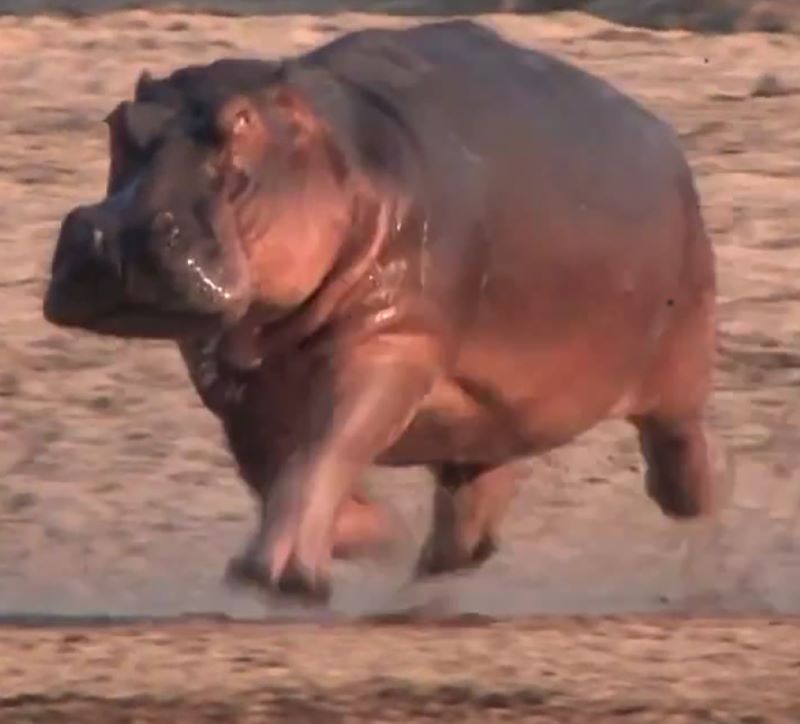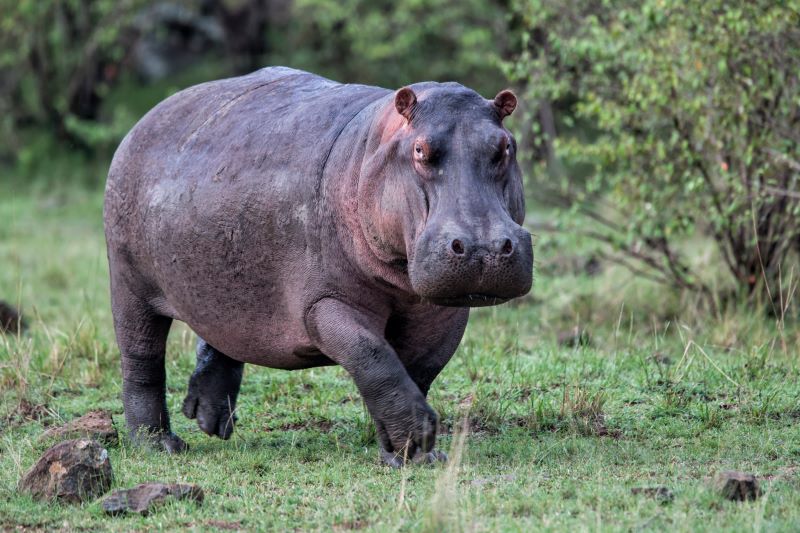RVC research discovers hippos' ability to become airborne
A new study from the Royal Veterinary College (RVC) into the movement and gaits of hippopotamuses on land has found that while they almost exclusively trot, the fastest-moving hippos become airborne for substantial periods of time. This research will improve scientific understanding of how the size of large animals influences their movement on land, support the reconstruction of the evolutionary biomechanics of hippo lineages and help veterinarians diagnose or monitor hippos that have problems moving or are experiences lameness.

Hippopotamuses are amongst the largest land animals, often reaching masses greater than 2,000 kilograms. They are better known for spending much of their time in water but little is known, scientifically, about how hippos move on land. Some previous studies have claimed they often use a standard quadrupedal walk, with a footfall sequence of left hind, left fore, right hand, right fore – similar to elephants; whereas other studies have claimed they trot with their diagonal feet in synchrony. Additionally, prior research hasn’t identified whether hippos become airborne when they move quickly, as is the case with many other mammals, such as horses, but less common amongst larger animals.
Conducting this research, which was led by John Hutchinson, Professor of Evolutionary Biomechanics at the RVC, and former RVC undergraduate student, Emily Pringle, the team collected video footage from Flamingo Land Resort in Yorkshire, recording how two hippos moved in their paddock during the day. They also sourced video footage from the internet of hippos moving, providing a broader range of behaviours and movements compared to those in captivity. In total, this dataset comprised 169 cycles of locomotion from 32 individual hippos.
Analysing the data, the researchers found that from a biomechanics perspective, hippos almost exclusively trot – even when slowly walking or quickly running. This is unusual for land animals, which tend to have a wider repertoire of gaits – for example, rhinoceroses can use a standard quadrupedal walk, trotting and galloping as they increase speed; much like a horse. Additionally, the analysis of the video footage revealed, for the first time, that the fastest-moving hippos become airborne, sometimes for substantial periods (about 15 percent of the stride cycle; or 0.3 seconds).
The findings from this study broaden the scientific understanding of what giant land animals can do and demonstrate considerable diversity in how they move. For example, elephants, which reach the largest sizes, can only do typical walking (not trotting) and never leave the ground with all four feet, but can still ‘run’ somewhat quickly. Rhinos can use the same breadth of gaits that smaller land animals can, although they are slower than smaller mammals, while hippos can trot and be airborne, pushing the apparent limits of what giant land animals can do, even though they are amphibious.

Professor John Hutchinson, Professor of Evolutionary Biomechanics and lead author of the study, said:
“Our study was about as simple as biomechanics research can get. Anyone can take a camera or internet videos and learn something about how animals move from that footage. It’s hard to work with hippos as they tend to stick to the water, and very seldom are trained to be studied in zoo collections. They’re also very dangerous. That’s part of the reason why science knew little about how hippos move before our research.
“We’re thrilled to provide the first study purely focused on revealing how hippos walk and run. We were pleasantly surprised to see how hippos get airborne when they move quickly – it’s really impressive!”
Kieran Holliday, Science and Conservation Officer at Flamingo Land Resort, said:
“I am delighted that we could help facilitate and aid in the collection of this valuable data in this exceptional publication. Understanding more about the species we work with, will only help us to improve the care we can give them in the future, and the fact that this paper has uncovered possible new discoveries into hippo locomotion could have positive impacts to the wider zoo community in regards to husbandry and enclosure design.”
Notes to editors
Picture credit Figure 5: Johan Vermeulen. CC-BY 4.0 license.
Reference
Hutchinson JR, Pringle EV. 2024. Footfall patterns and stride parameters of Common hippopotamus (Hippopotamus amphibius) on land. PeerJ 12:e17675 DOI 10.7717/peerj.17675
For more information please contact:
- Jasmin De Vivo jasmin.devivo@plmr.co.uk or rvc@plmr.co.uk
- Press Line: 0800 368 9520
About the RVC
- The Royal Veterinary College (RVC) is the UK's largest and longest established independent veterinary school and is a Member Institution of the University of London.
- It is one of the few veterinary schools in the world that hold accreditations from the RCVS in the UK (with reciprocal recognition from the AVBC for Australasia, the VCI for Ireland and the SAVC for South Africa), the EAEVE in the EU, and the AVMA in the USA and Canada.
- The RVC is ranked as the top veterinary school in the world in the QS World University Rankings by subject, 2024.
- The RVC offers undergraduate and postgraduate programmes in veterinary medicine, veterinary nursing and biological sciences.
- The RVC is a research-led institution, with 88% of its research rated as internationally excellent or world class in the Research Excellence Framework 2021.
- The RVC provides animal owners and the veterinary profession with access to expert veterinary care and advice through its teaching hospitals and first opinion practices in London and Hertfordshire.
You may also be interested in:
-
New research from the RVC explores the functions of leg muscles and structures in running
Research from the Royal Veterinary College (RVC) has explored the functions of leg muscles, …

